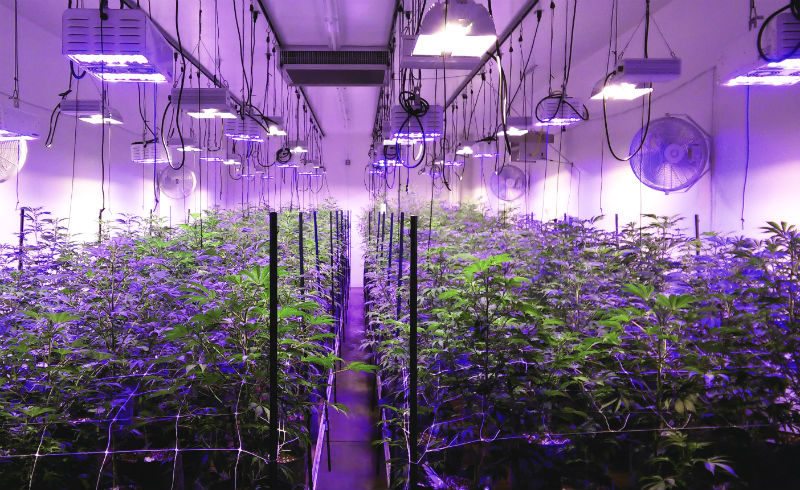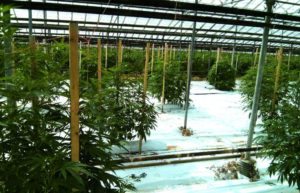
Time for a Reality Check
As more states legalize the use of cannabis for medicinal and recreational use, commercial plant growers, who have seen their profit margins drop to single digits, may consider cannabis production as a quick way to increase their bottom line. News stories of growers making exorbitant amounts of money producing cannabis might cause some commercial ornamental and vegetable growers to go after what they see to be quick money.

Fred Green at Fred Green Cannabis Consulting in Princeton, Massachusetts, who grew cut flowers for 30 years, has transitioned from the production side of ornamental plants to assisting companies looking to enter the cannabis industry. Green has consulted on the design and operation of warehouse and greenhouse cannabis production facilities in Massachusetts, Alaska, Colorado, Maryland, Washington, Canada and Australia.
Having had the opportunity to work on a number of cannabis projects, Green is able to offer some insight as to what are some of the misconceptions and challenges investors and growers have encountered when looking to start cannabis production operations.
The process for obtaining a license to produce cannabis is relatively easy and without risk.
Green says every state has different regulations and the cannabis industry is fractured due to the different regulations. There are eight states that allow recreational marijuana. Within those eight states, the medicinal regulations are different from the recreational regulations.
“Every state is different,” says Green. “Some states’ regulations don’t require that a grower be a resident, but other states do require a grower be a resident. It varies from state to state.”
“A more important factor is some states initially only have a certain number of grower licenses that are issued. In Maryland recently there were 149 applications for 15 grower licenses. When state regulators were deciding on the licenses they were looking for grower expertise and experience in dealing with cannabis. Obviously, if you are a commercial grower in Maryland, because growing cannabis is illegal in the state, you are not going to have any experience.”
Green says this requirement for being familiar with growing and handling cannabis has enabled people from states that have legalized cannabis, including Colorado, Washington and California, to apply and receive licenses in other states because they have experience with the crop. While one might expect state residents would have an advantage over outsiders coming in and receiving the licenses, that generally is not the case.
“Massachusetts officials bring in people from states like Colorado where cannabis is already being grown, and they try to learn what those regulators have learned and then apply that to Massachusetts,” he explains. “It’s difficult to take the same rules and regulations that apply in another state and apply them to Massachusetts or anywhere else.”
Green says another obstacle can be the licensing process which varies from state to state. “Maryland regulators vastly underestimated the interest and the number of applications that they would receive,” he says. “Originally it was supposed to take three months to process the applications. It took up to 10 to 11 months for regulators to make decisions. They had to go through and check every applicant’s background information and then they had to evaluate their business plans. People who had tied up real estate, thinking they were going to get a license, were left with substantial carrying costs.”
The application fees can also be costly. Green says Connecticut charges a $25,000 nonrefundable application fee and a $75,000 yearly licensing fee to producers.
“The application and planning expenses can be high, $80,000 to $100,000, including hiring a consultant, but that amount does not include the percentage of your company that most consulting groups from Colorado or California require to come on board,” he says. “The 4 to 5 percent ownership can add up to millions of dollars. That’s why growers need to work with accountants and lawyers.”
Like the commercial greenhouse ornamental and vegetable industries, the cannabis industry uses state-of-the-art production methods and equipment.
Green said much of the cannabis industry uses primitive production facilities and methods.
“Many commercial cannabis growers started out as closet growers,” says Green. “They know how to grow five, 10 or maybe 20 plants. But in the warehouse and greenhouse facilities that are now being constructed, production has increased to hundreds and even thousands of pots per week. From an ornamental plant perspective, a thousand plants per week for a greenhouse grower is nothing. Most cannabis growers are doing 400 to 500 pots per week. That is a huge stretch for someone who has only grown five or 10 plants at a time.”
“The cannabis industry is very young right now. As the competition increases, the prices will drop and margins will shrink. This will cause investors to start looking to commercial plant growers to figure out how the production can be done more efficiently using potting machines, conveyors, carts, automatic watering, etc. Currently many closet growers don’t want to use drip irrigation because they prefer to water the plants by hand so they can look at each plant every day. That is great if you are growing 20 plants, but try growing 20,000 plants. Hand watering just doesn’t work.”

Green says he has received many questions from investors about the cannabis production facilities he has designed.
“Investors who are putting up the money told me that the facilities I have helped design are not the industry standard,” he shares. “I told them that the industry standard was created by closet growers who are not experienced in producing plants commercially on a large scale. They’ve grown a few plants in their basement or closet and that is the industry standard. The industry standard needs to change.”
One example of how Green is changing the standard is with the lights he is installing in warehouse facilities.
“Investors are asking me why I want to use LEDs (light emitting diodes),” he says. “They say nobody uses LEDs, everybody uses high pressure sodium.
I told them I chose LEDs because they are efficient, they have the optimal spectrum, the return on investment is outstanding, and the grower can change the spectrum from the beginning to end of the crop. There are less air conditioning requirements with LEDs. And the operating expenses for LEDs are a fraction of what they are with HPS.”
A grower needs to have years of underground experience to produce a good cannabis crop.
According to Green, having someone on board who has grown cannabis is beneficial but is only one of the inputs that’s needed.
“The majority of inputs should come from the people who have years of experience growing plants on a commercial level,” he says. “It’s a good idea to have someone who has grown cannabis before. It’s still just a plant, but it is different in that you are trying to produce the most potent flower buds possible. I can grow the most beautiful lilies and mums, but that’s not what you are trying to do with cannabis.”
“With cannabis you are trying to grow a plant that produces a lot of THC (tetrahydrocannabinol) for recreational purposes and CBD (cannabidiol) for medicinal purposes. One of the ways to produce more THC is to stress the plant right at the end of the production cycle. The plant produces more THC because the chemical is one of its defense mechanisms. Some growers, for example, turn the lights off for the last five days. Other growers allow the substrate to dry out severely and water stress the plants. One grower who is using LEDs has found that by exposing the plants to more blue light right at the end has resulted in higher levels of THC.”

Cannabis is considered an agricultural produce so agricultural rules and regulations apply.
Green said cannabis production is frequently classified as “industrial” or “manufacturing.”
“When I talk about industrial or manufacturing that refers more to indoor cannabis production facilities,” he explains. These warehouse operations are considered manufacturing facilities so that copper pipe and not PVC pipe has to be used for plumbing systems.
“PVC is the favorite choice of commercial flower growers,” he says. “It’s cheap and it can be cut with a saw and glued together. Copper pipe is very expensive, it’s much harder to sweat the joints together and it’s not as forgiving as PVC. Manufacturing and industrial facilities require copper be used all the way into the grow rooms. So it is much more expensive than what a typical commercial grower is used to installing.”
“Right now in Massachusetts all of the facilities are indoors rather than in greenhouses because of security issues. I expect over the next few years greenhouses will be allowed to produce cannabis.”
Green says he expects in five years or less, the majority of new cannabis production will be done in greenhouses.
“Warehouse facilities are too costly to build and too costly to operate,” he says. “One facility I am working on currently is 36,000 square feet and costs over $6 million. The electric bill for this facility will be about $800,000 a year just to run the lights and air conditioning. A grower can build over an acre of nice greenhouses for around $600,000. With a greenhouse facility there is a cost to heat it, and some artificial light is required during the winter. But it’s not nearly as expensive to run as a warehouse operation.”
Green says growers who are producing an ornamental crop like pot mums who want to switch to cannabis will face a major challenge because of security issues.
“Cannabis production operations have to be fenced in and equipped with some expensive equipment including motion detectors, card readers, lasers and cameras,” he says. “Most states want to be able to see who entered the facility, what they were doing, how long they were doing it and when they left. It’s not as easy as putting up a couple of hoop houses and switching over from mums to cannabis.”
Cannabis will be a cash cow forever.
“The wholesale prices in Colorado have dropped by two-thirds over the last couple of years,” says Green. “There is a lot more competition. There are around 500 growers in Colorado now. Those people who have inefficient facilities, they are really going to struggle to make money at the lower prices.”
Some states, including California, Washington and Oregon, have a sizable outdoor cannabis production segment.
“When the outdoor crops are harvested during September and October, the prices plummet,” says Green. “Last year it took almost until January before the prices started to rebound.”
Green says he spoke with one Washington grower who changed his production schedule so that he didn’t harvest any product in October and November because he didn’t think that he would be able to sell it.
“The grower emptied out his greenhouses before the outdoor-grown crop started to be harvested,” he says. “He replanted his crop while the outdoor plants were being harvested. Like indoor growers, the outdoor growers have to acquire a license and meet certain criteria. They’re limited as to how much area they can plant. Obviously outdoor production is a much smaller investment than building an indoor facility or a greenhouse, but there is more risk of insect and disease problems.”
For more information: Contact Fred Green Cannabis Consulting at 508.395.6321 or fredgreen@sprintmail.com, or visit www.fredgreenconsulting.com.



